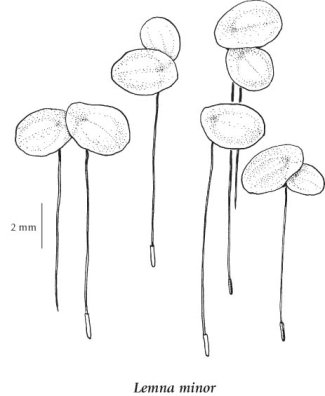common duckweed (water lentil)
Lemnaceae
Introduction to Vascular Plants
Introduction click to expand contents
Turion duckweed, or red duckweed, is a native species in North America that is found in eutrophic (basic) quiet waters. It is found across the continent but is not reported, so far, in southeastern US states or in parts of the Arctic (USDA Plants Database 2010). It was collected twice in BC in 1978 by John Pinder-Moss (Hatzic Slough near Mission) and since then has been collected from several locations (south of Fort Langley, Deer Lake in Burnaby, Chilliwack, Hatzic Slough, Silverdale, and Swan Lake in Victoria.
Turion duckweed closely resembles common duckweed (Lemna minor). However, fronds are flat, more symmetrical, thinner, and are reddish coloured on the lower surface, unlike common duckweed. Additionally, Armstrong (2010) says L. turionifera has "a row of minute papules along the midline which are absent in L. minor". This is the only Lemna species that produces turions (overwintering buds). A detailed species description is provided in Flora North America. Additionally, Wayne Armstrong provides detailed taxonomic information for separating species in the Lemnaceae, as well as many good photos. Turion duckweed is now present and invasive in Europe. |
Species Information click to expand contents
General:
Fronds annual, free-floating, usually in pairs, elliptic, rounded or broadly egg-shaped, 2-6 mm long, unstalked, quickly becoming detached, obscurely 3-nerved, the young plants produced from a pair of marginal pouches near the base of the frond.
Notes:
The separation of L. turionifera from L. minor, based on characters which are usually absent in BC or are sometimes found in L. minor, is not practical in this flora. Lemna turionifera has dark green or brown winter buds and fronds which are 3- to 5-nerved and purple-red beneath.
Illustration click to expand contents

If more than one illustration is available for a species (e.g., separate illustrations were provided for two subspecies) then links to the separate images will be provided below. Note that individual subspecies or varietal illustrations are not always available.
Illustration Source: The Illustrated Flora of British Columbia
Ecology click to expand contents
The table below shows the species-specific information calculated from
original data (BEC database) provided by the BC Ministry of Forests and Range.
(Updated August, 2013)
| Site Information |
Value / Class |
||
|
Avg |
Min |
Max |
|
| Elevation
(metres) |
821 | 20 | 1230 |
| Slope
Gradient (%) |
0 | 0 | 3 |
|
Aspect (degrees) |
176 | 160 | 190 |
| Soil
Moisture Regime (SMR) [0 - very xeric; 4 - mesic; 8 - hydric] |
7 | 7 | 8 |
| Modal
Nutrient Regime
Class |
E | ||
| #
of field plots species was recorded in: |
44 | ||
| Modal
BEC Zone Class |
IDF | ||
|
All BEC Zones (# of stations/zone) species was recorded in |
BG(3), BWBS(1), CDF(1), ICH(1), IDF(23), PP(7), SBPS(4), SBS(4) | ||
|
Source:
Klinkenberg 2013
|
|||
Habitat and Range click to expand contents
Status Information click to expand contents
Synonyms click to expand contents
Synonyms and Alternate Names:
Lemna cyclostasa Ell. ex Schleid.
Lemna minima Chev. ex Schleid.
Taxonomic Keys click to expand contents
1. Fronds oblong to lanceolate, 6-12 mm long, long-stalked, remaining attached in a zig-zag chain, usually submersed..................Lemna trisulca
1. Fronds elliptic, rounded or broadly egg-shaped, 2-6 mm long, unstalked, quickly becoming detached, floating on the surface...............Lemna minor |